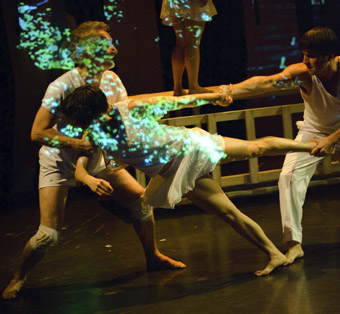dancing through trauma
jemima kemp: katrina lazaroff’s pomona road

Pomona Road
photo Nick Lane
Pomona Road
MAYBE THEY’RE CALLED NUCLEAR FAMILIES NOT BECAUSE THEY CLUSTER AROUND A STABLE CENTRE BUT BECAUSE THEY COLLIDE AND SCATTER, DESCRIBE ORBITS. BECAUSE OF THEIR PUSH-PULL OF ATTRACTION AND REPULSION. BECAUSE AT THE HEART OF FAMILY IS NOT STABILITY BUT A NEVERENDING CLEAVING TOGETHER AND FLYING APART. ENERGY THAT DISASSEMBLES BUT IS NEVER DESTROYED. KATRINA LAZAROFF’S POMONA ROAD ASKS WHAT HAPPENS WHEN THESE FLUID CONFIGURATIONS COLLIDE WITH THE BLANK WALL OF TRAUMA.
Lazaroff has cast her dancers as an archetypal family: Mum, Dad, the two sisters and a brother, an ‘every family’ that allows an audience to examine the questions that come with each disaster—What would I do? How could we, would we survive?
Trauma here comes as the destruction of the family home by bushfire and its elision of history and identity. The family is cut loose, each member forced to reimagine themselves, and it’s this territory that Pomona Road charts. The dynamic energy of family and eruptive trauma combine as a double helix propelling Pomona Road in a play between dissolution and stability.
The pivotal event of the bushfire is one from Lazaroff’s own history: her family lost a home to fire in 1980 and lived through the 1983 Ash Wednesday bushfires. This intimacy and assuredness with the material pervades the work. The spoken recollections from family and friends of their bushfire experiences provide an overarching narrative structure which drives and frames the action as well as providing historical specificity.
Pomona Road’s strength lies in the quality and integration of its elements. Choreography that keeps the dancers in almost constant motion captures a sense of particles moving. The immersive and evocative projections of Nic Mollison, the fine set design by Kerry Reid and Richard Seidel, Sascha Budimski’s driving and atmospheric score and the dramaturgy of Catherine Fitzgerald all contribute to the work’s tight storytelling.
Time and place are called forth through projections—TV shows, the bush and later flames, sparks, drifting leaves and wallpaper patterns over monumental cut-out tree shapes arranged around the space. There are the sounds of local radio, the susurration of trees and narrators recollecting the beauty and danger of the hills.
Lazaroff deploys her dancers in dissolving and reforming constellations marking out relationships and alliances. Dad and Mum economically describe a duologue of power, the girls pull each other into and out of orbits, father and son raise fences, tumble and grasp. Flying off, regrouping, they graze past each other, tracing out all the lineaments of family.
Like classical tragedy, momentum runs towards and away from the inexorable fact of the fire. Jagged synthesiser motifs and sonorous drones prefigure the fire’s arrival— “It’s gonna get us this time.” Drowning in flames the family frantically cross and recross each other’s trajectories, a dense interwoven panic climaxing with the father screaming silently, consumed by flames, the family at his feet.
As Antigone discovers in Anouilh’s tragedy, it’s not the event that matters but the aftermath where the tragedy unfolds. Against luminous burnt trees and floating home-plans that mark out the characters’ bodies as rooms—‘bedroom,’ ‘bath,’ ‘living’—trauma recurs as sparks and flames overlay and leak into their new, fragile ‘normal.’
A daughter shakes out a joyless little shimmy as the family don cast-off clothes — “Thank the nice lady.” Fat electronica builds anxiety as dreams of a new home dissolve into fire with the family becoming a mesh of hard diagonals on the floor, arms and legs thrown up in the air, verbal ejaculations like involuntary physical tics: “I have to do everything,” “It’s not my turn,” “He started it.”
Balanced against incipient chaos is a neat invocation of the family car, the only fixed point in all this loose energy. Dad drives, Mum as passenger, kids in the back. Pre-fire they bicker to sweet guitar pop, lean into the curves together, working as a unit. In the cold aftermath, eyes shut, isolated, they lean forward, lean back, stop cold in shock.
Moving through this post-bushfire world, in the way we get hooked on songs that speak to certain moments in our lives, we hear Gerry Rafferty’s “Baker Street.” Its nostalgia doubly captured in time, the song becomes an obsessive refrain of loss and longing: “And when you wake up it’s a new morning, the sun is shining it’s a new morning. You’re going, you’re going home.”
Circling around their vanished property, looping through the event, the family endlessly draw themselves to their own centre—“You’re going home.”
Pomona Road, director, choreographer, producer Katrina Lazaroff, performers Carol Wellman, Peter Sheedy, Veronica Shum, Emma Stokes, Zac Jones, lighting, projection, design Nic Mollison, set design Kerry Reid, Richard Seidel, sound design Sascha Budimski, dramaturg Catherine Fitzgerald, voiceovers Nick and Stena Lazaroff, Chris Lazaroff, Margie Hann Syme, Trevor Syme; presented in conjunction with Adelaide Festival Centre’s inSpace program; The Space, Adelaide Festival Centre, April 21-24
RealTime issue #97 June-July 2010 pg. 28






